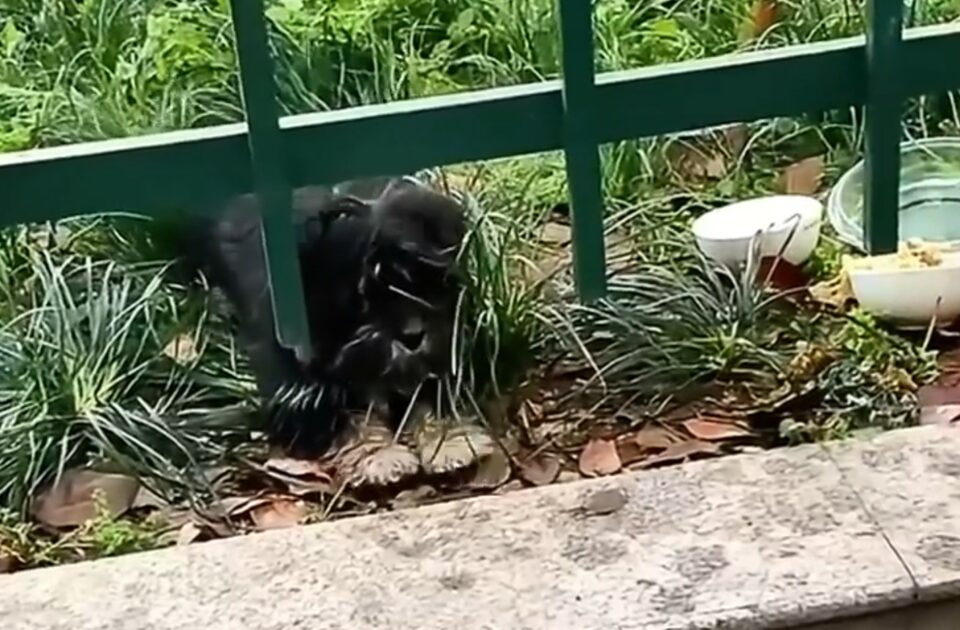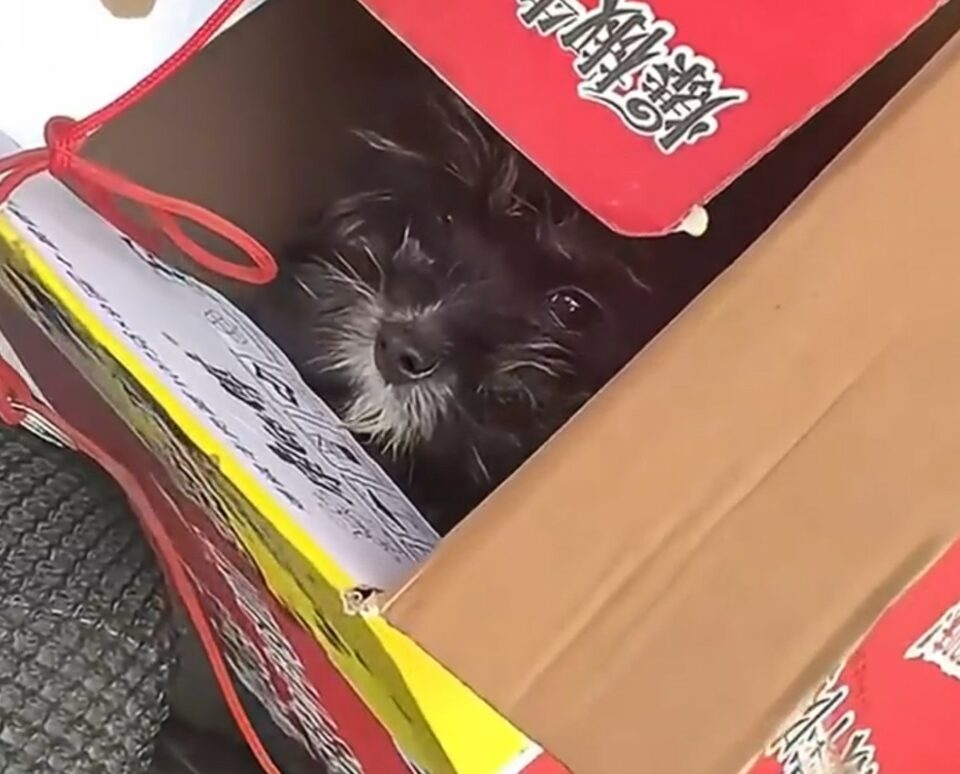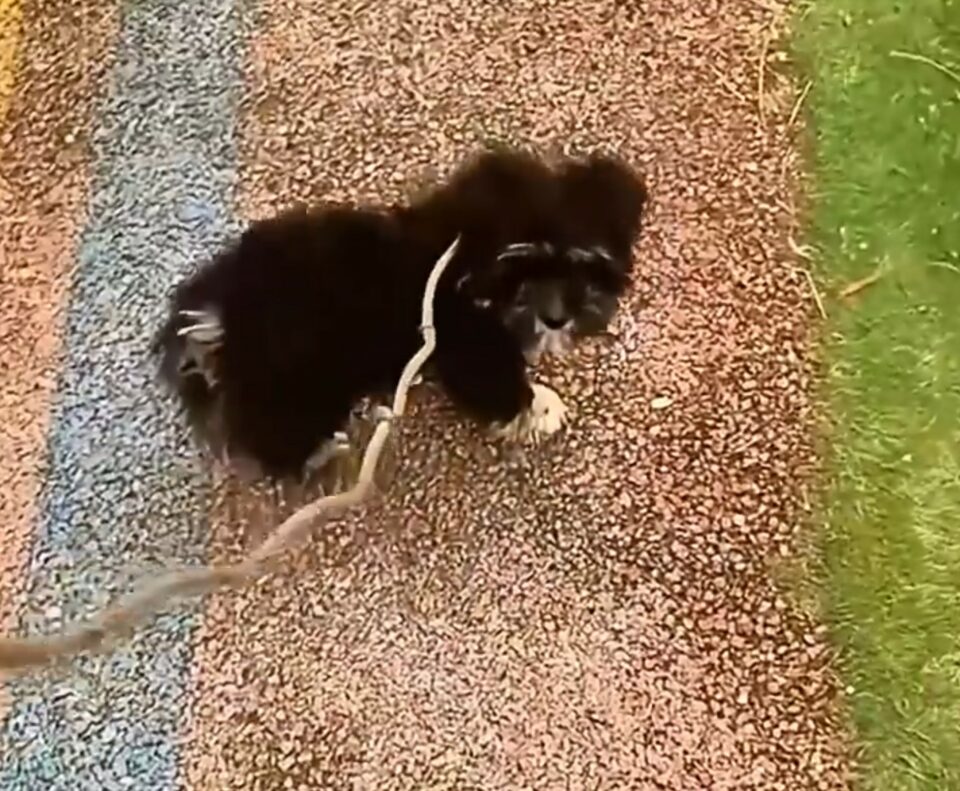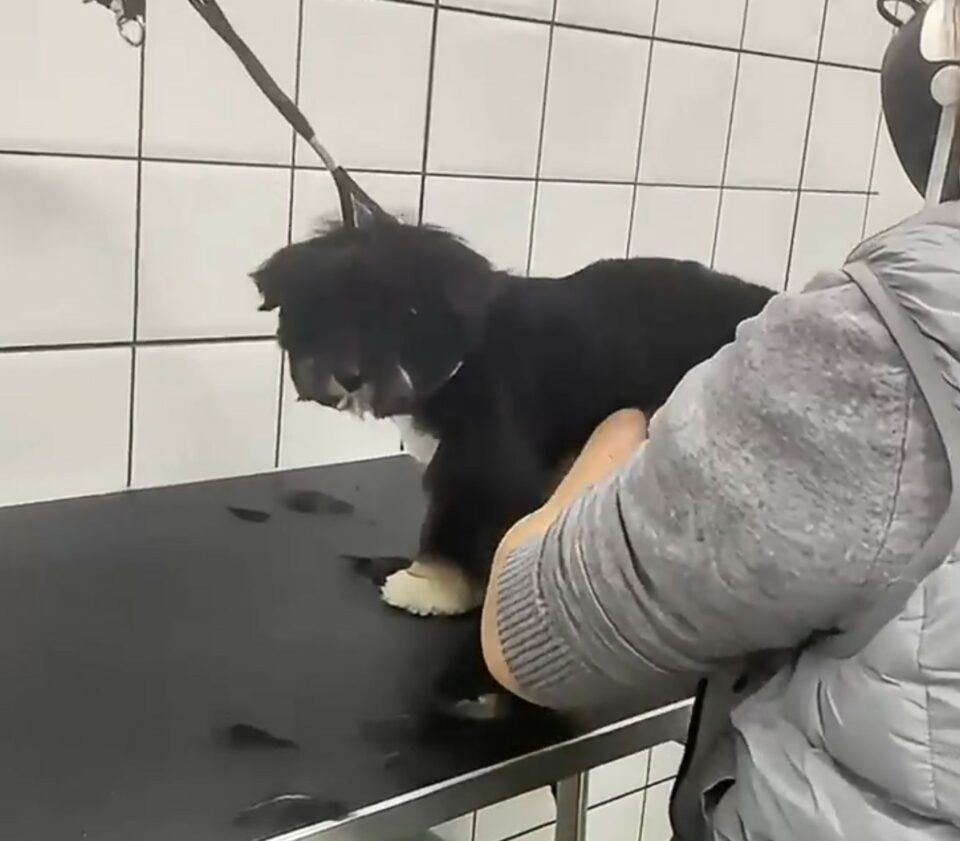The life of stray dogs is never an easy one.
They spend their days outside, trying to find shelter to hide from the elements and hoping that a kind soul would offer them some food to fill up their hungry stomachs.
The pup of today’s story was one of these puppies. She was a stray dog her entire life who lived in a hole, surviving off of scraps handed to her by passers-by.
She usually loved spending time with these hoomans; however, one day, when the temperature was really low, the puppy decided to hide inside of her hole and refused to come out.
New Chapter

Fearing that something may be wrong, a lady decided to finally offer this sweet girl a home.
When a man who was feeding her this entire time heard of this wonderful news, she immediately offered to help catch her and take her to the ladie’s home.
Luckily, the puppy did not put up a fight at all and gladly came with the lady to her new home.

But, before they came home, they decided to stop by the vet in order to receive a thorough checkup.
Even though the pup seemed a bit frightened, the vet managed to examine her teeth and found out that she was only four months old. After the medical examination deemed that this was a healthy and happy pup, she and her new owner were on their way to start their new lives.

In Her New Home
The puppy needed some time to get used to her new environment.
She didn’t really like being on a leash, and even the slightest sound would startle her. Luckily, over time, her timid nature disappeared, and she started coming out of her shell.

After receiving her very first bath and grooming, this sweet girl transformed into the cutest little girl ever.
She was now not only all nice and clean with a loving family, but she also had incredible doggo siblings who loved spending their days having super fun play dates together.
Finally, this beautiful girl was a part of a loving family.
She no longer had to worry if a kind hooman would offer her food as she now had everything she needed and so much more!

Take Care Of The Strays
Unfortunately, she isn’t the only animal who grew up as a stray animal surviving on the streets, but she also doesn’t have to be the only one who has such a happy ending.
Even though the shelters do everything they can to take in as many animals as they can and offer them a loving home, they have limited space and resources.
However, with your help, everything can change.
So please, head down to your local shelter, offer an animal in need a loving home, and help be the change this world needs.
If you’ve ever owned a furry companion, you know that their health is a top priority. One of the most concerning illnesses that can affect dogs, especially puppies, is parvo. This highly contagious virus can be a serious threat to your canine friend’s well-being. Understanding what parvo is and how it can impact your dog is crucial for every pet owner.
Imagine the joy of bringing home a new puppy, only to face the fear of them falling ill to parvo. As a seasoned dog trainer, you’ve witnessed the devastation this disease can cause. In this article, we’ll shed light on the ins and outs of parvo in dogs, equipping you with the knowledge to protect your four-legged companions.
Understanding Parvo in Dogs
If your dog hasn’t been vaccinated against parvo, they could be at risk of contracting this highly contagious virus that can be especially severe in puppies.
What is Parvo?
Parvo, short for parvovirus, attacks rapidly dividing cells in a dog’s body, particularly in the intestines and bone marrow. This can lead to severe dehydration, intestinal damage, and a weakened immune system.
How is Parvo Transmitted?
Parvo spreads through contact with infected feces or contaminated environments. Dogs can contract the virus by sniffing or licking contaminated areas, such as grass, soil, or objects.
Signs and Symptoms
Early signs of parvo include lethargy, loss of appetite, vomiting, and bloody diarrhea. If your dog shows these symptoms, it’s crucial to seek veterinary care immediately.
Treatment and Prevention
Treatment for parvo involves intensive care, including fluid therapy, antibiotics, and supportive care. Vaccination is key to preventing parvo; puppies should receive a series of vaccinations starting at around 6-8 weeks of age.
Recovery and Prognosis
Recovery from parvo can be challenging and depends on the dog’s overall health and the severity of the infection. With prompt treatment, many dogs can survive and go on to lead healthy lives.
Remember, early detection and vaccination are essential in protecting your furry friend from the dangers of parvo. If you suspect your dog may have parvo, don’t hesitate to contact your veterinarian for immediate care.
Causes of Parvo in Dogs
When it comes to understanding parvo in dogs, knowing the causes is crucial. Here are the primary factors that contribute to the spread and development of this dangerous virus:
- Viral Source: Parvo in dogs is mainly caused by the canine parvovirus Type 2 (CPV-2). This highly contagious virus attacks the rapidly dividing cells in a dog’s body, especially targeting the intestinal lining and bone marrow.
- Direct Contact: One of the most common ways dogs contract parvo is through direct contact with an infected dog or contaminated environment. The virus can survive in the environment for months, making it easy for dogs to pick it up.
- Fecal-Oral Route: Dogs can also get infected by licking or sniffing contaminated feces. The virus particles shed in an infected dog’s feces are extremely resilient and can spread easily through this route.
- Fomites Transmission: Parvo can be spread through contact with contaminated objects, such as food and water bowls, leashes, toys, bedding, or any surface that an infected dog has come into contact with.
- Unvaccinated Dogs: Puppies and unvaccinated adult dogs are at a higher risk of contracting parvo due to their underdeveloped immune systems. Lack of proper vaccination leaves them vulnerable to the virus.
Understanding these causes can help you take necessary precautions to protect your furry friend from this deadly disease. Early detection and prompt veterinary care are essential in managing and preventing the spread of parvo in dogs.
Symptoms and Effects of Parvo in Dogs
Parvo in dogs presents a range of symptoms that can have serious effects on their health and well-being. Recognizing these signs early can help in providing prompt treatment and care for your furry friend.
Symptoms to Watch Out For:
- Lethargy: If your dog is unusually tired and lacks energy, it could be a sign of parvo.
- Loss of Appetite: Dogs infected with parvo may show a sudden disinterest in food.
- Vomiting: Persistent vomiting, especially if it is frequent and severe, can indicate a problem.
- Bloody Diarrhea: One of the hallmark signs of parvo is bloody diarrhea, which requires immediate attention.
Effects on Your Dog:
- Dehydration: The combination of vomiting and diarrhea can lead to dehydration, a common complication of parvo.
- Weakened Immune System: Parvo attacks the dog’s immune system, making them more susceptible to other infections.
- Organ Damage: In severe cases, parvo can cause damage to a dog’s organs, posing a grave risk to their health.
Immediate Veterinary Care Is Crucial
Remember, if you notice any of these symptoms in your dog, seek veterinary assistance immediately. The effects of parvo can escalate rapidly, and timely intervention is essential for your dog’s recovery and well-being.
Diagnosis and Treatment of Parvo in Dogs
Diagnosis:
When it comes to diagnosing parvo in dogs, your vet will conduct various tests. A fecal antigen test is commonly used to detect the virus in your dog’s stool. Additionally, blood tests might reveal a decrease in white blood cells and an increase in specific enzymes, indicating parvo infection.
Treatment:
Treating parvo in dogs is intensive and typically requires hospitalization. The primary goals are to combat dehydration, control vomiting and diarrhea, and prevent secondary infections. Your dog may receive supportive care such as intravenous fluids, antibiotics, anti-nausea medication, and nutritional support.
Recovery:
The recovery process for dogs with parvo can be challenging. It’s crucial to follow your vet’s instructions diligently, including administering medications, monitoring diet, and ensuring a clean environment. Gradual improvement in symptoms is a positive sign, but complete recovery may take weeks, and some dogs may have lasting health issues.
Importance of Early Intervention:
Early detection and immediate treatment significantly increase the chances of survival for dogs with parvo. If you notice symptoms like lethargy, vomiting, or diarrhea, don’t hesitate to contact your vet. Quick action is vital in combating this serious and potentially fatal virus in dogs.
Vaccination:
Prevention is key when it comes to parvo. Vaccinating your dog against the virus is the best way to protect them. Puppies should receive a series of vaccines starting at 6-8 weeks of age, with booster shots given regularly. Consult your vet to create a vaccination schedule tailored to your dog’s needs.
Challenges:
While treatment for parvo is available, not all dogs survive the virus. Factors such as the age of the dog, overall health, and how quickly treatment is initiated can impact the outcome. Understanding the risks and being proactive in prevention and early intervention is essential for safeguarding your furry companion against parvo.
Remember, prompt veterinary care, vaccination, and vigilance are key in managing parvo in dogs effectively and ensuring the well-being of your beloved pet.
Preventing Parvo in Dogs
To keep your furry friend safe from parvo, follow these essential preventive measures:
1. Vaccination:
Ensure your dog is up to date with their vaccinations, including the parvo vaccine. Vaccination is key to building immunity against the virus.
2. Limit Exposure:
Avoid areas where infected dogs may have been present, such as parks or kennels. Reduce interactions with unfamiliar dogs to minimize the risk of exposure.
3. Maintain Cleanliness:
Regularly clean your dog’s living environment, including their bedding, toys, and food/water bowls. Disinfect these areas to prevent the spread of the virus.
4. Quarantine Infected Dogs:
If you have multiple dogs and one is diagnosed with parvo, isolate the infected dog to prevent the spread of the virus to other pets in the household.
5. Consult Your Vet:
Discuss a prevention plan with your veterinarian. They can provide guidance on the best practices to protect your dog from parvo based on your pet’s health and lifestyle.
6. Early Detection:
Be vigilant for symptoms of parvo, such as vomiting, diarrhea, lethargy, and loss of appetite. Early detection can help in prompt treatment and prevent the virus from escalating.
7. Professional Guidance:
Seek advice from a veterinary professional on additional preventive strategies, especially if you have specific concerns about your dog’s risk of exposure to parvo.
By following these preventive measures, you can significantly reduce the risk of your dog contracting parvo and ensure their well-being and longevity.
Conclusion
That’s the lowdown on parvo in dogs. Remember, staying informed, acting fast, and taking preventive steps are key to keeping your furry friend safe. Keep an eye out for any unusual symptoms, seek veterinary help promptly, and stick to a solid vaccination and hygiene routine. By staying proactive, you’re not just protecting your pup from parvo but also ensuring their happiness and health for years to come.
Frequently Asked Questions
What is parvo and why is it dangerous for dogs, especially puppies?
Parvo is a highly contagious virus that attacks a dog’s gastrointestinal tract, leading to severe vomiting, diarrhea, and dehydration. Puppies are particularly vulnerable due to their weaker immune systems.
How can I tell if my dog has parvo?
Common symptoms of parvo include lethargy, loss of appetite, severe diarrhea with blood, and vomiting. If you notice these signs, consult a veterinarian immediately.
How is parvo diagnosed?
Veterinarians typically use fecal antigen tests or blood tests to diagnose parvo in dogs. Early detection is crucial for prompt treatment.
What is the treatment for parvo?
Treatment often involves hospitalization, intravenous fluid therapy, antibiotics to prevent secondary infections, and supportive care to combat dehydration and restore electrolyte balance.
Can dogs recover from parvo?
With timely and intensive treatment, many dogs can recover from parvo. However, the recovery process can be challenging, requiring close monitoring and care.
How can I prevent my dog from getting parvo?
Vaccination is key to preventing parvo. Additional preventive measures include limiting exposure to infected areas, maintaining cleanliness, quarantining infected dogs, and consulting with a vet for a prevention plan. Early detection of symptoms is crucial for timely intervention.
[no_toc]

Hey there, I’m Janet Brooks, a dog-loving student from California. I’m all about helping pups in need, especially those without homes. Me and my awesome friends work together to give shelter and love to stray dogs. Oh, and I also write blogs about dogs to share helpful info.